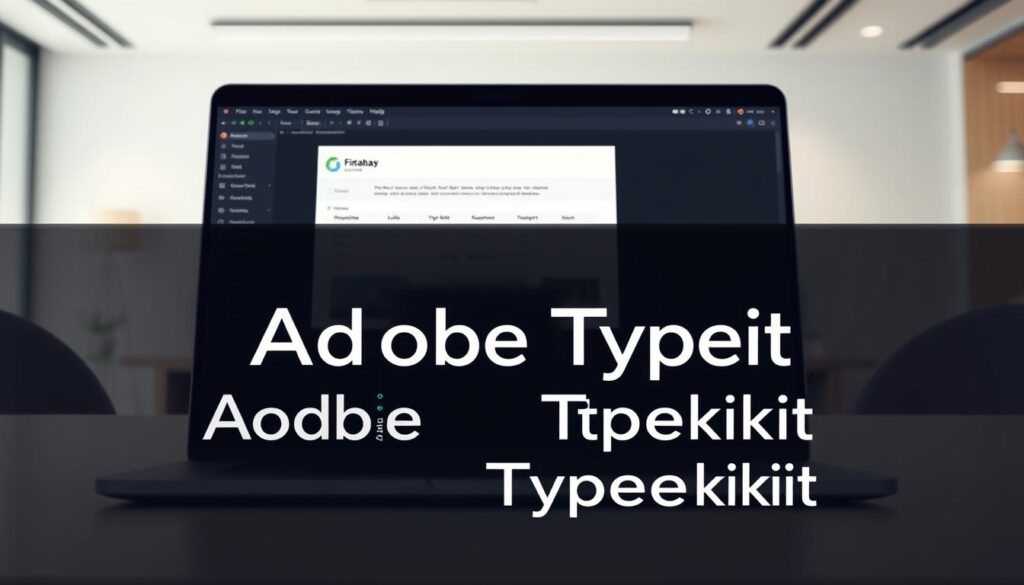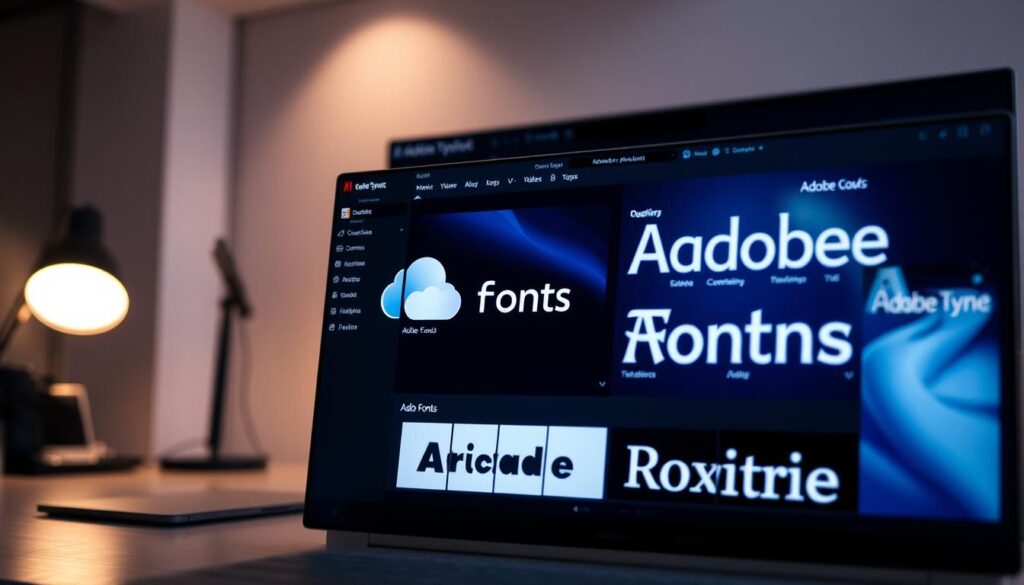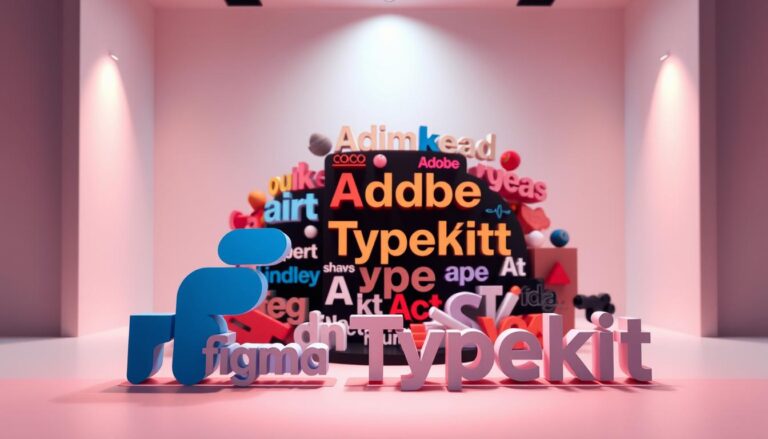In the world of design, collaboration and efficiency are key. Combining Figma with Adobe Fonts creates a seamless workflow that empowers creative professionals. This integration allows designers to access a vast library of high-quality fonts without the hassle of manual installations.
By leveraging this partnership, teams can maintain consistency across their projects. Fonts activated through the Adobe Fonts Desktop App sync effortlessly with Figma, ensuring everyone works with the same typeface settings. This eliminates confusion and speeds up the design process.
Real-time collaboration becomes even more powerful when tools like these work together. Whether you’re brainstorming ideas or finalizing a project, this integration enhances creativity and productivity. It’s a game-changer for modern design teams.
Key Takeaways
- Figma and Adobe Fonts work together for seamless font integration.
- Access a vast library of high-quality fonts without manual setups.
- Maintain design consistency across all team members.
- Streamline workflows for faster project completion.
- Enhance creativity and productivity in real-time collaboration.
Understanding Figma and Adobe Typekit Integration
Modern design thrives on seamless tools and integrations. Combining Adobe Fonts with Figma creates a streamlined workflow that empowers designers. This partnership allows access to a vast library of high-quality fonts, enhancing creativity and efficiency.

The Role of Adobe Fonts in Modern Design
Adobe Fonts plays a crucial role in modern design by offering a diverse collection of typefaces. Designers can access Adobe Fonts directly within Figma, eliminating the need for manual installations. This ensures consistency across projects and speeds up the design process.
Benefits for Collaborative Design Projects
Using Adobe Fonts in Figma enhances collaboration among team members. Everyone works with the same fonts, reducing confusion and improving efficiency. Real-time updates ensure that changes are reflected instantly, making it ideal for collaborative projects.
This integration also supports creativity by providing a wide range of typography options. Designers can experiment with different styles while maintaining brand consistency. It’s a powerful solution for modern design teams.
Setting Up Your Creative Cloud and Adobe Fonts Desktop App
Getting started with Creative Cloud and Adobe Fonts is simple and efficient. This setup ensures that your fonts are always accessible and ready for use in your design projects. The process involves downloading the Adobe Fonts Desktop App and syncing it with your Creative Cloud account.

Installing the Adobe Fonts Desktop App
To begin, download the Adobe Fonts Desktop App on your system. It’s compatible with both Windows and MacOS. Once installed, sign in with your Adobe ID to link it to your Creative Cloud account. This step ensures that all your fonts are synced and ready to use.
After installation, the app automatically syncs your fonts, making them available across your system. This eliminates the need for manual installations and ensures consistency in your projects.
Activating Fonts for Use in Figma
Once the app is set up, activating fonts is straightforward. Open your Creative Cloud account and select the fonts you want to use. These fonts will sync with the desktop app and become available in Figma’s font dropdown menu.
If you encounter issues, ensure your system meets the app’s requirements. Restarting the app or your computer can often resolve minor glitches. This setup streamlines your workflow and ensures fonts are reliably accessible.
- Download the Adobe Fonts Desktop App on Windows or MacOS.
- Sign in with your Adobe ID to sync fonts with Creative Cloud.
- Activate fonts from your Creative Cloud account for use in Figma.
- Ensure your system meets the app’s requirements for smooth operation.
- Troubleshoot issues by restarting the app or your computer.
Configuring Settings in Figma for Adobe Fonts
Streamlining your design workflow starts with mastering font settings. Figma’s intuitive interface makes it easy to navigate the font menu and customize typography for your projects. Whether you’re using Adobe Fonts or importing custom fonts, these tools ensure consistency and creativity.
Navigating the Figma Font Menu
Accessing the font menu in Figma is straightforward. Open the text layer and click the dropdown menu to see all available fonts. Adobe Fonts appear alongside other options, making it easy to switch between styles.
Use the tab and option settings to adjust text layers effectively. This ensures your design remains consistent across multiple devices and projects.
Importing Custom Fonts into Your Projects
For designers who need unique typography, importing custom fonts is a game-changer. Figma supports this feature, allowing you to upload fonts directly into your projects. This gives you full control over your font options and enhances creative flexibility.
Ensure the fonts you import are marked as available use in your workflow. This step guarantees that your team can access the same fonts, maintaining consistency in collaborative projects.
By mastering these settings, you can elevate your design process and achieve professional results every time.
Integrating figma adobe typekit into Your Design Workflow
Effortlessly integrating fonts into your design workflow can transform how you create. By leveraging the font library available through Adobe Fonts, designers can streamline their process and focus on creativity. This integration ensures consistency and efficiency across all projects.
Step-by-Step Font Activation Process
Activating fonts in your design tool is a straightforward process. First, ensure your Adobe Fonts Desktop App is installed and linked to your Creative Cloud account. This step allows designers to access a vast collection of typefaces without manual installations.
Next, open your design project and navigate to the font dropdown menu. Select the desired fonts from the Adobe Fonts library. The cloud ensures these fonts are synced across all devices, making them instantly available for use.
Finally, confirm the fonts are functional within your project. This seamless process allows designers to merge creative assets quickly, reducing technical hurdles and enhancing workflow efficiency.
Enhancing Creativity with Seamless Integration
The integration of Adobe Fonts into your design tool supports a more creative and efficient workflow. Designers can experiment with a wide range of typography options while maintaining brand consistency. This flexibility is ideal for collaborative projects, ensuring everyone works with the same fonts.
Real-time updates through the cloud keep fonts synchronized across team members and devices. This eliminates confusion and ensures that changes are reflected instantly. By using Adobe Fonts, designers can elevate project aesthetics and achieve professional results every time.
This well-defined process empowers designers by integrating robust tools into a unified creative environment. It’s a game-changer for modern design teams looking to enhance their workflow and creativity.
Best Practices for Typography and Collaborative Design
Typography plays a pivotal role in shaping brand identity and enhancing collaboration. Consistent text styles ensure that your designs communicate effectively and maintain a professional look. By leveraging a well-curated fonts library, designers can establish uniform styles that reflect brand identity across all projects.
Optimizing Text Styles for Consistent Branding
To achieve consistent branding, start by defining your typography guidelines. Use Figma text tools to create reusable text styles for headings, subheadings, and body text. This ensures that every team member uses the same styles, reducing inconsistencies.
Accessing a diverse fonts library allows designers to experiment while maintaining brand standards. Tools like Adobe Fonts make it easy to sync fonts across devices, ensuring everyone has access to the same typefaces. This is especially useful for web and mobile projects where consistency is critical.
Here are some expert tips for optimizing text styles:
- Define a hierarchy for headings, subheadings, and body text.
- Use a limited set of fonts to maintain a cohesive look.
- Regularly update your fonts library to include new options.
- Test typography on different devices to ensure readability.
| Best Practice | Benefit |
|---|---|
| Define text hierarchy | Improves readability and structure |
| Use a limited font set | Maintains brand consistency |
| Sync fonts across devices | Ensures access for all team members |
| Test on multiple devices | Guarantees readability in all formats |
By following these best practices, every designer can create with confidence and maintain high standards of visual branding. Consistency in typography not only enhances design quality but also strengthens communication in collaborative environments.
Conclusion
Integrating a robust fonts library into your design process can elevate your work to new heights. By leveraging seamless tools, designers can access font options effortlessly, ensuring consistency and creativity in every project. This integration not only simplifies workflows but also enhances collaboration among team members.
Setting up your account correctly is crucial for smooth operation. Ensure your application settings are optimized to make the most of the available resources. This step guarantees that every designer can use the tools effectively, reducing technical hurdles and boosting productivity.
Remember, an important note is to regularly check your setup to avoid disruptions. By following best practices, you can ensure that your projects reflect your creative vision. This approach empowers both individual designers and collaborative teams to achieve professional results consistently.
In summary, this integration streamlines the design process, making it easier to access font options and maintain brand consistency. It’s a powerful solution for modern design needs, ensuring every project meets high standards of quality and creativity.
